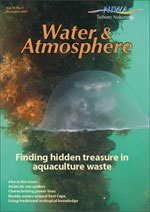PDF of this article (134 KB)


Hauraki Gulf snapper - stay-at-homes, or wandering tourists?
You can help us better understand snapper movements. Snapper are an important finfish species in northern New Zealand. Our understanding of their movements – both for individuals and for populations – remains relatively poor, with important implications for fish and habitat management. To address this gap, last summer we tagged almost 10 000 snapper across the greater Hauraki Gulf, using external yellow dart tags.
To date, over 250 tags have been returned, and we’re beginning to see a range of different movement behaviours. For instance, although all snapper were tagged in the Greater Hauraki Gulf, some 6% of returns have come from the Bay of Plenty, ranging from Cape Colville to Whale Island (about 230 km away), along with places in-between, such as Cuvier, Great Mercury, Alderman, and Slipper Islands, and off Tauranga Harbour. In the winter months, snapper have been turning up farther north around the rocky reefs of Great Barrier Island, and in deeper waters (70–100 m) off Little and Great Barrier Islands. In stark contrast to these long-distance movers, other snapper have remained at ‘home’, effectively being re-caught where they were released in the Hauraki Gulf.
We expect many tagged snapper will move inshore again over the summer, and it will be very useful to assess whether they return to the location at which they were tagged (homing behaviour) or, alternatively, randomly re-assort themselves across inshore locations. The key to successfully answering such questions will be getting sufficient numbers of tag returns from fishers. So, if you are lucky enough to catch a tagged snapper, please contribute to this research programme; it will be much appreciated!
This project is supported by the Foundation for Research, Science & Technology and the Department of Conservation.
For further information, contact: Dr Mark Morrison, 09-375 2063, [email protected]
What to do if you catch a tagged snapper
If you catch a tagged snapper, you can make a valuable contribution to this research by ringing the phone number on the tag and providing these important details:
- tag number
- date
- location
- depth
- fish length
- whether the fish was caught over reef or over soft sediment.
If the fish that you catch is undersized and therefore cannot be landed, simply measure its length, cut off the tag, and release the fish. All tags returned (with associated data) go into a monthly prize draw to win a rod-and-reel combination valued at $350.
The phone number to ring (weekdays, 9 to 5) is 09-375 2050.
Muddy waters international


Marine ecologist Drew Lohrer has recently returned from a three-month exchange at Nagasaki University in southern Japan. In consultation with the Royal Society of New Zealand, the Japan Society for the Promotion of Science (JSPS) awarded him a prestigious Invitation Fellowship to work with Professor Akio Tamaki, one of Japan’s foremost authorities on intertidal sandflat ecology. Together with Professor Tamaki and his students and colleagues, Drew examined the effects of sediment deposition on populations of commercially important bivalves.
In Japan, rivers swollen by monsoon rains deliver terrestrial sediments to coastal waters, and estuarine tidal flats are damaged by the muddy deposits that result. In 2002 and 2006, Professor Tamaki documented catastrophic events where mud deposits up to 30 cm thick smothered whole populations of bivalves before they could be harvested. Drew timed his 2007 visit to coincide with the monsoon season and was able to sample a significant deposition event on the Shirakawa tidal flat (Ariake Sound, Kyushu) in mid July. After the peak rains, a homogenous layer of mud more than 10 cm thick extended for almost 2 km2. The impacts of terrestrial sediment deposition were clearly evident for the sandflat’s three dominant bivalve species.
The results of this research project complement the on going interdisciplinary investigations of Professor Tamaki and his coastal engineering colleagues who study sediment-transport dynamics. They are progressing towards an understanding of complicated ecological interactions mediated by complex physical forces, such as salinity gradients and wave and tidal hydrodynamics. Terrestrial sediment deposition is a significant problem in New Zealand and throughout the Pacific Rim, and Drew’s Invitation Fellowship has planted the seeds for an enduring collaborative relationship. Professor Tamaki plans to visit Drew at NIWA in Hamilton next April.
For further information, contact: Dr Drew Lohrer, 0-7-859 1803, [email protected]
